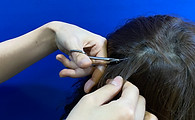여성산후탈모
여성산후탈모
산후탈모가 시작한지 6개월이 지나도 회복이 되지않으면 막연히 회복을 기다리기 보다는 즉시 진단과 치료를 하시는 것이 바람직합니다.

산후탈모란?
산후탈모란 여성이 출산 후 겪는 급격한 탈모를 말합니다. 주로 호르몬이 임신동안 모발의 변화와 산후탈모의 가장 큰 원인이 됩니다.
이는 출산으로 인한 빈혈과 호르몬의 변화 등으로 복합적으로 나타납니다.
산후탈모와 호르몬의 관계
임신 중에는 호르몬의 급격한 변화로 에스트로겐, 프로게스테론, 옥시토신, 프로락틴을 포함한 몇 가지 다른 호르몬 수치를 증가시킵니다. 임신기간 동안 혈류량도 증가해 출산 예정일까지 정상 체적보다 50% 이상 증가합니다. 아기가 태어나자마자 에스트로겐과 프로게스테론을 포함한 호르몬 수치가 빠르게 떨어져 출산 후 24시간 이내에 거의 정상 수준으로 돌아올 것입니다.
혈류량도 천천히 감소하게 되고 아기가 태어난 몇 주 후에 정상으로 돌아오게 됩니다. 호르몬이 안정되면서 임신과 관련된 호르몬 변화가 몸에 미치는 영향은 서서히 가라앉고 머리카락이 정상으로 돌아올 것 입니다.
산후탈모는 언제부터?
산후탈모란 여성이 출산 후 겪는 급격한 탈모를 말합니다. 주로 호르몬이 임신동안 모발의 변화와 산후탈모의 가장 큰 원인이 됩니다.
산후 탈모는 아기가 태어난 후 어느 날이라도 발생할 수 있는데, 이론적으로는 출산 후 에스트로겐 수치가 떨어지면서 모낭이 휴지기에 접어들고 모발이 더 적게 자라게 됩니다. 그리고 약 100일이 지나면 머리카락이 탈락하기 시작해 때로는 1년 동안 지속될 수도 있는데 보통 4개월 전후로 최고조에 달합니다.
산후탈모는 언제까지?
사람에 따라 다를 수 있지만 산후탈모는 보통 출산 후 6개월 정도 지나면 성장하기 시작해 12개월 내로 임신 전 상태로 돌아가야 합니다.
만약 1년이 되여가도 여전히 빗에 뭉친 머리카락 덩어리가 지고, 얇은머리가 그대로 유지가 된다면 탈모에 대한 추가적인 원인이 없는지 꼭 확인해 보시는 것을 권해 드립니다.
*경우에 따라서는 저활성 갑상선 질환과 같은 갑상선 질환이 탈모를 일으킬 수도 있습니다.
임산부&수유부 미녹시딜 복용금지
미녹시딜은 바르는 발모제로 남성, 여성에게 모두 사용이 가능합니다. 원래는 혈관확장제로 사용되었으며 혈관이 확장되면서 탈모를 억제하는 효과가 있어 탈모약으로 사용되고 있습니다.
현재 탈모를 완치시킬 수 있는 기술이 개발되지 않았기 때문에 탈모약은 복용하면 꾸준히 계속 사용해야합니다.
18세 미만, 임부 또는 임신하고 있을 가능성이 있는 여성과 수유부에게는 유해할수 있어 사용하지 않습니다.

의료진의 풍부한 경험이 필요
산후탈모의 양상과 예후예상 또한 풍부한 임상경험에서 나옵니다.
디테일한 검사결과를 파악하고 치료 필요성 여부 정확히 판단해야 합니다.
수면패턴이 불가피하게 불규칙하기 때문에 적절한 조언을 드려야 합니다.

정확한 탈모진단
10년 넘게 탈모치료와 모발이식을 집도한 경험을 바탕으로 오직 모발만을 연구해 왔습니다

정직한 진료
치료가 필요없는 환자에게 치료권유를 하지않습니다
예후진단으로 치료여부를 결정하며, 자연�치유의 확률이 크신 분은 바로 치료하지 않고 관찰만 합니다
환자의 두피상태, 탈모진행상황을 고려해 적합한 탈모치료계획을 제안해드립니다


정확한 진단

STEP 1
두피진단 기초검사

STEP 2
모발 성장속도 검사

STEP 3
혈액검사

STEP 4
모발조직 중금속 검사
필수검사
선택검사

STEP 5
세포막 투과검사

STEP 6
타액/호르몬 검사

STEP 7
근체형 검사

STEP 8
활성산소검사

STEP 9
생기능/생활습관검사
THL 검사
Total Hair Loss Test
THL검사란?
THL(Total Hair Loss) 검사란 모리의원의 체계적인 탈모진단 검사로 4가지의 필수검사(두피 진단 및 기초 검사, 모발 성장 속도 검사, 혈액 검사, 모발 조직 중금속 검사)와 5가지의 선택검사(세포막 투과 검사, 타액/호르몬 검사, 근체형 검사, 활성산소 검사, 생기능/생활습관 검사)로 이루어져 있습니다.
모리의원의 치료
모리의원에서는 스테로이드를 사용하지 않는 탈모치료와 피부염치료를 하고 있습니다

핵산-성장인자주사 치료
발모 효과가 있는 핵산
많은 종류의 성장인자 성분

면역영양치료
모발성분검사를 통한 결핍성분 파악 후 공급하는 수액치료
핵산, 성장인자, 비타민, 미네랄, 아미노산, 간해독, 비타민효과 증폭물질

재생라이트 치료
복합파장
두피개선과 재생을 돕는 치료
1) 핵산-성장인자주사 치료
발모 효과가 있는 핵산과 많은 종류의 성장인자 성분들을 두피에 직접 주사하여 모낭에 영양을 공급하고 발모를 촉진 시킵니다.
2) 면역영양 치료
산후 수유기는 산모가 식이요법에 신경을 쓰지 못해 소화흡수가 잘 되지 않거나 영양섭취가 단조롭고 불균형하거나 지나치게 조절해 영양결핍/과잉을 초래합니다.
영양불균형을 해소를 개선하려면 영양치료를 통해 손상된 모낭을 복구하고 모발성분검사를 통하여 정확한 상태를 파악한 후 개선해 나가면 치료효과를 더욱 배가시킬 수 있습니다.
수액 치료는 핵산, 비타민, 미네랄, 아미노산, 간해독, 비타민 효과 증폭물질 등을 융합한 개인 맞춤치료입니다.
3) 재생라이트 치료
복합파장을 원리로 두피환부 전체에 조사하여 약화된 모낭을 튼튼하게 하고 두피개선과 재생을 돕는 치료법입니다.
※ 산후 허약해진 몸의 회복을 돕기 위해 비타민과 미네랄 보충제를 복용하시는게 도움이 됩니다.